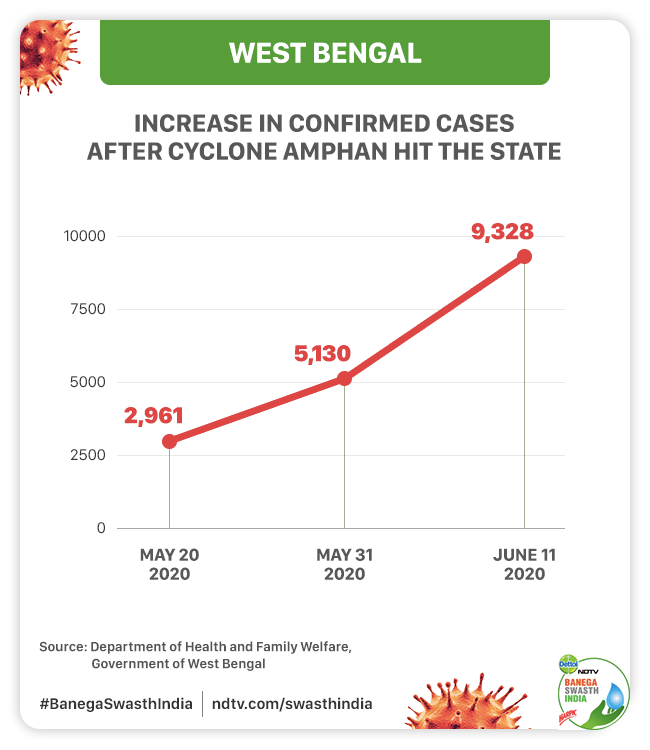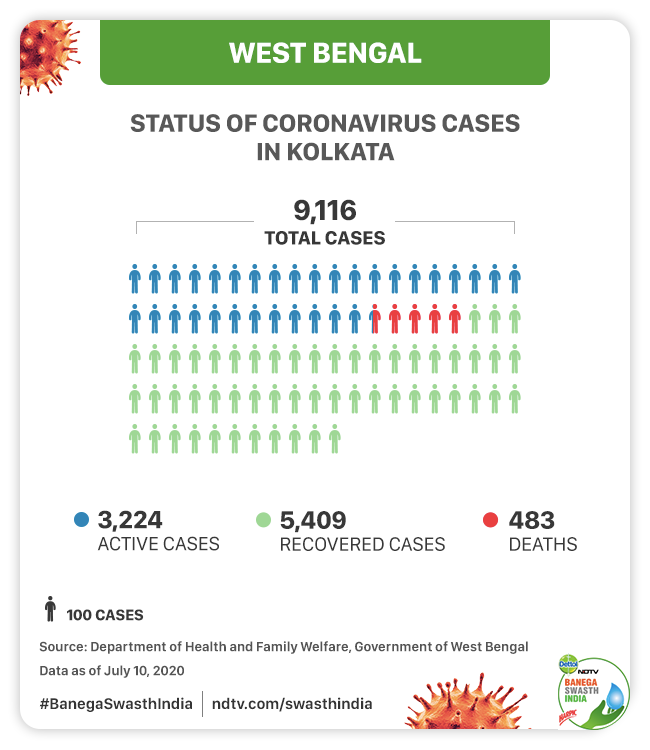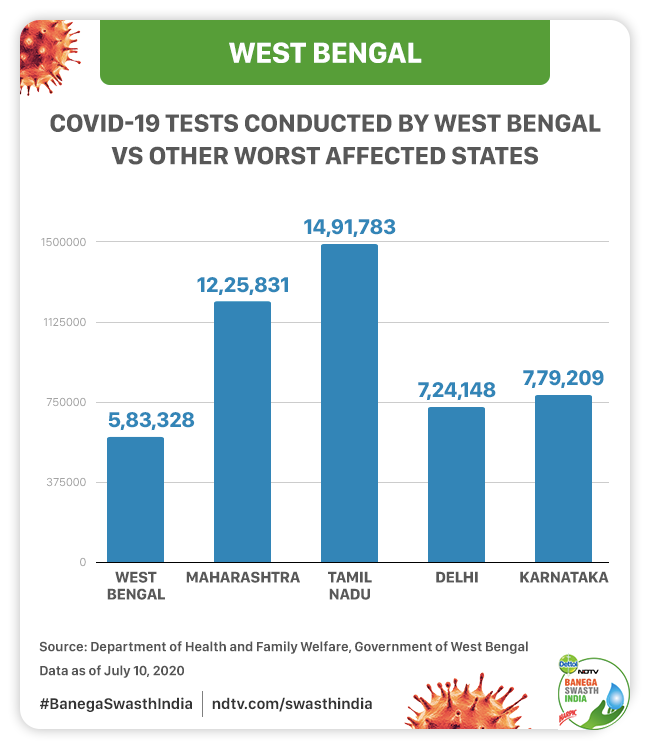Highlights
- As on July 10, West Bengal had 9,531 active COVID-19 cases
- West Bengal has dedicated 80 hospitals for treatment of COVID-19
- The state is testing over 10,000 people every day
New Delhi: West Bengal, is among the top 10 states in the country that are the worst affected by COVID-19. Apart from dealing with the pandemic, the state is also dealing with a trail of devastation left by the Super Cyclone Amphan that hit the state between May 16 and May 21. The storm that was considered to be the strongest to hit the region in over a decade, killed over 90 people in the state and forced over 8 lakh people to seek shelter in flood rescue centres for days, with some already occupied by migrants returning from other states due to the coronavirus lockdown, according to Dr Ajay Chakraborty, Director Health Services, West Bengal. Dr Chakraborty says that the disaster caused by the cyclone coupled with the return of migrant workers led to a spike in the COVID-19 cases in the state.
Before Amphan hit, 19 districts out of 23 had reported COVID-19 cases and the state had 2,825 number of COVID-19 cases and 172 number of deaths. This zoomed to touch a high of 3,667 number of cases and 200 number of deaths on May 24 after the cyclone had passed.
Here is how West Bengal has been fighting against COVID-19 and dealing with the aftermath of the cyclone Amphan.
Big Jump In Cases After Cyclone Amphan Hit The State, Capital Kolkata Became The Worst-Affected District
The first case of COVID-19 in West Bengal was reported on March 17 in Kolkata when a 18-year-old boy returned from United Kingdom, and tested positive. Another case was reported on March 20 of a 22-year-old man who had also returned from the United Kingdom. By April 17, one month after the first recorded cases, the total number of positive cases crossed the 300 mark (310) in terms of confirmed cases. The number of positive cases went up by over 2, 000 by May 17. According to Dr Chakraborty, this surge can be attributed to the previous infections, migrant influx, people returning from foreign countries via flights under Vande Bharat Mission, meant for the repatriation of Indians from around the world and to the increase in testing from less than 100 tests in the first week of April to over 8,000 tests per day in May.
The COVID-19 confirmed tally increased by over 2,100 cases within 10 days of the cyclone Amphan hitting the state and as of May 31, there were 5,130 confirmed cases in the state. The cases increased by over 4,100 within the next 10 days and on June 11, there were 9,328 confirmed cases in the state. According to the state administration, implementing social distancing became increasingly difficult among the people who were affected by the cyclone and were taking shelter in relief centres, most of which were already occupied by several migrant workers who were under quarantine.
As of July 10, West Bengal has reported a total of 27,109 positive cases, including 8,881 active cases. The total fatalities as on July 10 are 880 which is about 3.2 per cent of total cases, higher than the national average of 2.7 per cent. The state has been able to cure 17,348 people which is 63.9 per cent of total cases, higher than the national average of over 62.4 per cent, according to the data reported by the Department of Medical, Health and Family Welfare of West Bengal.
According to the data provided by the health department, 80.2 per cent of those dead were suffering from co-morbid conditions which refer to the presence of one or more additional physiological or psychological conditions like hypertension, diabetes, liver-issues among others.
The data provided by the state government also shows that in the last one week, the number of new infections has grown by an average of 5 per cent every day.
With 3,224 active cases in Kolkata, the state capital has about 33.8 per cent of West Bengal’s active cases. Out of the total cases (9,116) in Kolkata, more than half, 5,409 have been discharged while 483 people have succumbed to the disease as on July 10.
North 24 Parganas is the second worst-hit district with 5,273 cases, followed by Howrah which has 3,825 cases. The district of Jhargram has the least number of cases- 25 and Kalimpong has 56 cases.
Commenting on the rising number of cases in the state, Dr Chakraborty said,
Because of the cyclone Amphan, many people were shifted to rescue centres were people came in contact with each other since it was difficult to implement social distancing measures right away. So a lot of transmission of the infection has happened due to this. Apart from this, lakhs of migrant labourers have come back to the state. Now because of the partial lifting of the lockdown, people are mixing and this has posed a big challenge. Therefore we have imposed a complete lockdown in the area where the number of cases are high. Now the major challenge is that to manage the increasing number of cases so that they can get hospital beds and appropriate treatment.
Also Read: West Bengal Sets Up ‘COVID Warrior Club’ To Help Contain Pandemic
While Testing Has Improved, It Is Still Lagging Behind Other Worst Hit States
With no testing facility in March when initial cases were reported, the test samples were being sent to the National Institute of Virology (NIV), Pune. While testing was improved in April and as of July 10, 10,000 people are being tested every day, it is still lagging behind in comparison to other states like Maharashtra and Tamil Nadu which are testing over 30,000 samples every day.
West Bengal has conducted 5.8 lakh tests till now. This accounts to over 6,400 tests per million people, as on July 10, according to the Department of Medical, Health and Family Welfare which is less than the national average of over 6,859 tests per million people.
Currently, the state has 53 laboratories approved by the Indian Council of Medical Research (ICMR) for COVID-19 testing.
West Bengal’s Health Infrastructure And Challenges Faced By The First Responders At COVID Dedicated Hospitals
According to West Bengal’s Health and Family Welfare Department, as of July 10, there are 80 hospitals treating COVID-19 patients which include 26 government hospitals and 54 private hospitals. There are 10,830 beds for COVID-19 patients in government designated COVID-19 hospitals and 1,423 in private hospitals. The total number of ICU (Intensive Care Unit) beds is 948 and the total number of ventilators in the COVID hospitals is 395.
While talking about the state’s health infrastructure dedicated for COVID-19, Dr. Chakraborty said,We are increasing the number of beds so that more people can be accommodated. We also have high flow oxygen facilities in the hospital wards itself at major government hospitals dedicated to COVID-19 in order to provide treatment and oxygen support to people in the ward before getting an ICU bed. The whole strategy to fight COVID-19 revolves around saving the lives of the people. We are augmenting the ICUs, oxygen supplies, PPEs (Personal Protective Equipment) and all the other things required during the pandemic. I think we will be even more well equipped soon and will be able to tame the ‘curve’.
He further said that the state suffered problems in procuring PPEs initially. He said,
We have overcome the challenges related to the availability of PPEs successfully and now over 30,000 PPEs and masks are being produced in the state per day. We are in fact exporting PPEs to other states.
NDTV reached out to a doctor working in a COVID hospital to learn about the challenges faced by doctors, nurses and other healthcare staff in terms of adequacy of health infrastructure for fighting the pandemic. Dr. Saurav Mondal of KPC Medical College and Hospital in Jadavpur, Kolkata, which is currently treating 70 COVID-19 patients said,
The situations, as far as COVID-19 is concerned, are quite difficult here. Most of the patients that we are treating are asymptomatic. When a patient comes to the hospital with a COVID symptom, we admit them in the isolation ward and conduct the COVID-19 test. But most of the time, patients who do not show COVID symptoms visit the non-COVID ward in the hospital for some other ailment. Now the challenge is that almost all hospitals that are running non-COVID wards are facing deficiencies related to personal protection from the infection. The government is not providing masks and sanitisers for doctors, nurses and other healthcare staff who are on non-COVID duties even though they are in a vulnerable position of getting the infection as the number of asymptomatic patients is much larger than the symptomatic patients. However, I appreciate that the COVID wards are completely equipped with PPEs.
Also Read: Coronavirus Lockdown: This NGO Feeds Meals, Provides Essentials To Forest Dwellers In Sundarbans
Dr. Mondal further said that in a situation where a large number of medical staff is dedicated to responding to the pandemic, it is important to protect those doctors and nurses also who are working in non-COVID wards especially in the ENT (ear, nose, throat) department as they are directly exposed to the patient’s mouth and nose. He also highlighted that the state may face a shortfall of doctors for treating both COVID and non-COVID patients in the future as the classes of hospital interns and medical students. He said,
It will not be possible for the interns to take their final MBBS (Bachelor of Medicine and Bachelor of Surgery) exam without completing the practical studies at the hospital. Who will take the charge of duty in the future? A lot of doctors and nurses in hospitals in Northern parts of West Bengal are already infected and quarantined. Thus a shortfall of medical staff has already set in. This lack of doctors in government medical colleges will affect the poor and the marginalised the most as they cannot afford the treatment at private hospitals.
As far as the health services related to tropical and vector-borne diseases like Dengue, Malaria, are concerned, Pritam Roy, Health Expert in West Bengal said that the state faced a shutdown of all non-COVID health services in the state but the is slowly getting these services back on track. He said,
Vector-borne diseases are a big concern in the state, especially the Southern parts that were flooded due to the storm. Also, as the rainy season has set in which also brings with the threats of Malaria, Dengue, and Chikungunya. We have all been focusing on fighting the coronavirus since the past few months. Essential mosquito controlling programmes have been delayed this year. It is now the time to strengthen the defence against vector-borne disease because it will put further strain on healthcare infrastructure and make the COVID-19 pandemic situation worse.
During the initial period of the lockdown, the maternal and childcare services suffered to a large extent. While the regular immunisation programme and nutrition programs like POSHAN and MCHN (Maternal and Child Health and Nutrition) Day sessions are getting operational, it will still take some time for these services to get back on track. Subhankar Banerjee, one of the founders of SOUL, a non-profit charitable trust working towards supporting the poor and the needy in Sundarbans, said,
The destruction caused by Amphan has left the people here even more helpless. The difficult to reach out to tribes of Sundarbans have become even more difficult to reach out to now. There is no regular immunisation taking place in this area since past 4-5 months. The malnutrition prevalence among children and women is area is extremely high and most of the children here are suffering due to worms in their stomach.
Also Read: From Sanitisation To Surveillance IIT Kharagpur’s Alumni Develops Devices To Fight COVID-19
Early Responses Of State To The Pandemic
The state government started raising awareness among citizens on COVID-19 in January and February itself when the pandemic hit the country for the first time. This included advisories on observing precautionary measures, and informing citizens on travel restrictions, home isolation, and screening protocols for foreign returnees. During the first week of March, the state government responded to the growing number of suspected cases by issuing guidelines for preparedness by government medical colleges and hospitals. These guidelines covered admission, isolation and management of suspected COVID-19 cases. By the end of the second week of March, the government issued protocols for monitoring travellers in the state.
On March 16, the government notified the West Bengal Epidemic Disease COVID-19 Regulations, 2020. These regulations laid out screening and treatment protocol for COVID-19 patients, and authorised the district administration to take containment measures to curb the spread of COVID-19.
Right after the first confirmed case was reported in the state, the government of West Bengal issued orders regarding isolation wards and treatment protocols. The state ordered the closure of certain establishments on March 21 to restrict non-essential social gatherings and subsequently it went on to take measures to impose the nationwide lockdown.
Measures Undertaken By The State To Provide Relief To The Poor
The state government announced the free entitlement of wheat and rice to the 9.96 crore people in the state covered under the Public Distribution System, on the lines of the central government, until September 2020. Chief Minister Mamata Banerjee extended this initiative for one year till June 2021 on June 30. According to Dr. P Ulaganathan, District Magistrate of South 24 Parganas, all the district administrations in the state have made arrangements for providing shelters and food to the poor and needy people including the migrant workers.
According to the Chief Minister, the state government is taking up all kinds of measures for people’s welfare and to provide them support as the state fights against the contagion. She added that people must reciprocate by providing their cooperation and following government guidelines. While the state has started unlocking, it keeps imposing strict lockdown in containment zones as and when required. The state has also established its first plasma bank for treating COVID-19 patients at Kolkata Medical College and Hospital (KMCH). In order to control the spurt in confirmed cases, the state has formed a team of experts comprising senior doctors to monitor the containment measures.
Also Read: Swasth Report Of West Bengal: Anaemia In Women And Children Needs Attention
NDTV – Dettol Banega Swasth India campaign is an extension of the five-year-old Banega Swachh India initiative helmed by Campaign Ambassador Amitabh Bachchan. It aims to spread awareness about critical health issues facing the country. In wake of the current COVID-19 pandemic, the need for WASH (Water, Sanitation and Hygiene) is reaffirmed as handwashing is one of the ways to prevent Coronavirus infection and other diseases. The campaign highlights the importance of nutrition and healthcare for women and children to prevent maternal and child mortality, fight malnutrition, stunting, wasting, anaemia and disease prevention through vaccines. Importance of programmes like Public Distribution System (PDS), Mid-day Meal Scheme, POSHAN Abhiyan and the role of Aganwadis and ASHA workers are also covered. Only a Swachh or clean India where toilets are used and open defecation free (ODF) status achieved as part of the Swachh Bharat Abhiyan launched by Prime Minister Narendra Modi in 2014, can eradicate diseases like diahorrea and become a Swasth or healthy India. The campaign will continue to cover issues like air pollution, waste management, plastic ban, manual scavenging and sanitation workers and menstrual hygiene.
[corona_data_new]






![Uttarakhand CM asks officials to increase COVID-19 testings Dehradun (Uttarakhand) [India], July 26 (ANI): Uttarakhand Chief Minister Trivendra Singh Rawat on Saturday asked officials to rapidly increase COVID-19 testings. He said that adequate stock of essential materials related to COVID-19 should be kept in view of the monsoon season, the safety of the frontline workers should be taken care of. Reviewing the COVID-19 situation in the state, Rawat instructed officials to ensure that work in industrial institutions is not affected and the surveillance system is strengthened to prevent the spread of infection. He also directed Intelligence, LIU and Information Department officials to take strict action against those spreading false rumours on social media. "Strict action should be taken against such people who are moving within the state and giving any wrong information or hiding the truth. People who are coming from high-risk areas should be tested," the Chief Minister said. On the complaint regarding lack of coordination of staff at Haldwani Medical College, Rawat asked Kumaon Commissioner Arvind Singh Hyanki to take the responsibility himself. The Chief Minister said that strict action should be taken against officials who are negligent towards work. He said that effective control of COVID-19 and necessary resources and better facilities should be provided in COVID-19 Care Centres. Meanwhile, Garhwal Commissioner Ravinath Raman said that regular monitoring is needed at the state border and complete information of people coming into the state for official and personal purposes should be recorded.](https://w.ndtvimg.com/sites/3/2020/07/27111157/CSRC-WB5.png)



























